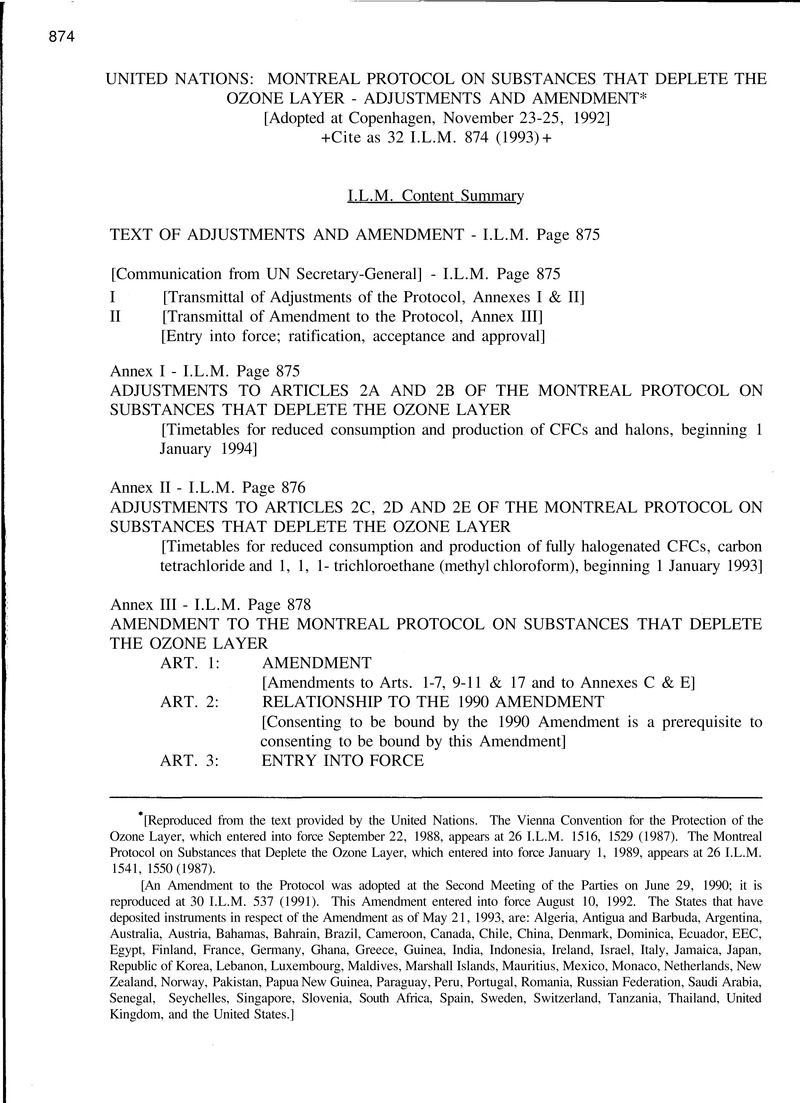Article contents
United Nations: Montreal Protocol on Substances that Deplete the Ozone Layer - Adjustments and Amendment
Published online by Cambridge University Press: 27 February 2017
Abstract

- Type
- Treaties and Agreements
- Information
- Copyright
- Copyright © American Society of International Law 1993
References
* [Reproduced from the text provided by the United Nations. The Vienna Convention for the Protection of the Ozone Layer, which entered into force September 22, 1988, appears at 26 I.L.M. 1516, 1529 (1987). The Montreal Protocol on Substances that Deplete the Ozone Layer, which entered into force January 1, 1989, appears at 26 I.L.M. 1541, 1550 (1987).
[An Amendment to the Protocol was adopted at the Second Meeting of the Parties on June 29, 1990; it is reproduced at 30 I.L.M. 537 (1991). This Amendment entered into force August 10, 1992. The States that have deposited instruments in respect of the Amendment as of May 21, 1993, are: Algeria, Antigua and Barbuda, Argentina, Australia, Austria, Bahamas, Bahrain, Brazil, Cameroon, Canada, Chile, China, Denmark, Dominica, Ecuador, EEC, Egypt, Finland, France, Germany, Ghana, Greece, Guinea, India, Indonesia, Ireland, Israel, Italy, Jamaica, Japan, Republic of Korea, Lebanon, Luxembourg, Maldives, Marshall Islands, Mauritius, Mexico, Monaco, Netherlands, New Zealand, Norway, Pakistan, Papua New Guinea, Paraguay, Peru, Portugal, Romania, Russian Federation, Saudi Arabia, Senegal, Seychelles, Singapore, Slovenia, South Africa, Spain, Sweden, Switzerland, Tanzania, Thailand, United Kingdom, and the United States.]
* Where a range of ODPs is indicated, the highest value in that range shall be used for the purposes of the Protocol. The ODPs listed as a single value have been determined from calculations based on laboratory measurements. Those listed as a range are based on estimates and are less certain. The range pertains to an isometric group. The upper value is the estimate of the OOP of the isomer with the highest OOP, and the lower value is the estimate of the OOP of the isomer with the lowest OOP.
** Identifies the most commercially viable substances with ODP values listed against them to be used for the purposes of the Protocol
* Where a range of ODPs is indicated, the highest value in that range shall be used for the purposes of the Protocol. The ODPs listed as a single value have been determined from calculations based on laboratory measurements. Those listed as a range are based on estimates and are less certain. The range pertains to at isomeric group. The upper value is the estimate of the ODP of the isomer with the highest ODP, and the lower value is the estimate of the ODP of the isomer with the lowest ODP.
- 4
- Cited by


